Tic-tac-toe
Tic-tac-toe (American English), noughts and crosses (Commonwealth English), or Xs and Os is a paper-and-pencil game for two players, X and O, who take turns marking the spaces in a 3×3 grid. The player who succeeds in placing three of their marks in a horizontal, vertical, or diagonal row is the winner.
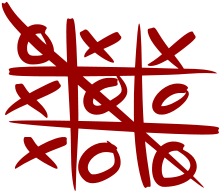 A completed game of Tic-tac-toe | |
| Genre(s) | Paper-and-pencil game |
|---|---|
| Players | 2 |
| Setup time | Minimal |
| Playing time | ~1 minute |
| Random chance | None |
| Skill(s) required | Strategy, tactics, observation |
| Synonym(s) | Noughts and crosses Xs and Os |
Game play
In order to win the game, a player must place three of their marks in a horizontal, vertical, or diagonal row.
The following example game is won by the first player, X:

Players soon discover that the best play from both parties leads to a draw. Hence, tic-tac-toe is most often played by young children, who often have not yet discovered the optimal strategy.
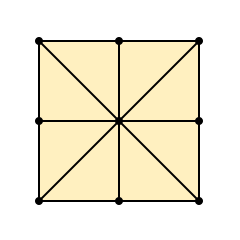
Because of the simplicity of tic-tac-toe, it is often used as a pedagogical tool for teaching the concepts of good sportsmanship and the branch of artificial intelligence that deals with the searching of game trees. It is straightforward to write a computer program to play tic-tac-toe perfectly or to enumerate the 765 essentially different positions (the state space complexity) or the 26,830 possible games up to rotations and reflections (the game tree complexity) on this space.[1] If played optimally by both players, the game always ends in a draw, making tic-tac-toe a futile game.[2]
The game can be generalized to an m,n,k-game in which two players alternate placing stones of their own color on an m×n board, with the goal of getting k of their own color in a row. Tic-tac-toe is the (3,3,3)-game.[3] Harary's generalized tic-tac-toe is an even broader generalization of tic-tac-toe. It can also be generalized as a nd game. Tic-tac-toe is the game where n equals 3 and d equals 2.[4] It can be generalised even further by playing on an arbitrary incidence structure, where rows are lines and cells are points. Tic-tac-toe is the game given by the incidence structure shown to the right, consisting of nine points, three horizontal lines, three vertical lines, and two diagonal lines, each line consisting of at least three points.
History
Games played on three-in-a-row boards can be traced back to ancient Egypt,[5] where such game boards have been found on roofing tiles dating from around 1300 BCE.[6]
An early variation of tic-tac-toe was played in the Roman Empire, around the first century BC. It was called terni lapilli (three pebbles at a time) and instead of having any number of pieces, each player only had three, thus they had to move them around to empty spaces to keep playing.[7] The game's grid markings have been found chalked all over Rome. Another closely related ancient game is three men's morris which is also played on a simple grid and requires three pieces in a row to finish,[8] and Picaria, a game of the Puebloans.
The different names of the game are more recent. The first print reference to "noughts and crosses" (nought being an alternative word for zero), the British name, appeared in 1858, in an issue of Notes and Queries.[9] The first print reference to a game called "tick-tack-toe" occurred in 1884, but referred to "a children's game played on a slate, consisting in trying with the eyes shut to bring the pencil down on one of the numbers of a set, the number hit being scored". "Tic-tac-toe" may also derive from "tick-tack", the name of an old version of backgammon first described in 1558. The US renaming of "noughts and crosses" as "tic-tac-toe" occurred in the 20th century.[10]
In 1952, OXO (or Noughts and Crosses), developed by British computer scientist Sandy Douglas for the EDSAC computer at the University of Cambridge, became one of the first known video games.[11][12] The computer player could play perfect games of tic-tac-toe against a human opponent.[11]
In 1975, tic-tac-toe was also used by MIT students to demonstrate the computational power of Tinkertoy elements. The Tinkertoy computer, made out of (almost) only Tinkertoys, is able to play tic-tac-toe perfectly.[13] It is currently on display at the Museum of Science, Boston.
Combinatorics
When considering only the state of the board, and after taking into account board symmetries (i.e. rotations and reflections), there are only 138 terminal board positions. A combinatorics study of the game shows that when "X" makes the first move every time, the game outcomes are as follows:[14]
- 91 distinct positions are won by (X)
- 44 distinct positions are won by (O)
- 3 distinct positions are drawn (often called a "cat's game"[15])
Strategy
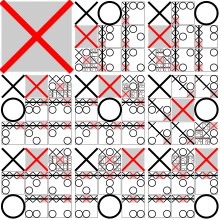
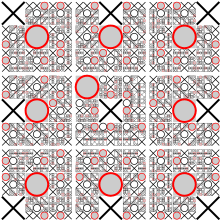
A player can play a perfect game of tic-tac-toe (to win or at least draw) if, each time it is their turn to play, they choose the first available move from the following list, as used in Newell and Simon's 1972 tic-tac-toe program.[16]
- Win: If the player has two in a row, they can place a third to get three in a row.
- Block: If the opponent has two in a row, the player must play the third themselves to block the opponent.
- Fork: Create an opportunity where the player has two ways to win (two non-blocked lines of 2).
- Blocking an opponent's fork: If there is only one possible fork for the opponent, the player should block it. Otherwise, the player should block all forks in any way that simultaneously allows them to create two in a row. Otherwise, the player should create a two in a row to force the opponent into defending, as long as it doesn't result in them creating a fork. For example, if "X" has two opposite corners and "O" has the center, "O" must not play a corner move in order to win. (Playing a corner move in this scenario creates a fork for "X" to win.)
- Center: A player marks the center. (If it is the first move of the game, playing a corner move gives the second player more opportunities to make a mistake and may therefore be the better choice; however, it makes no difference between perfect players.)
- Opposite corner: If the opponent is in the corner, the player plays the opposite corner.
- Empty corner: The player plays in a corner square.
- Empty side: The player plays in a middle square on any of the 4 sides.
The first player, who shall be designated "X", has 3 possible strategically distinct positions to mark during the first turn. Superficially, it might seem that there are 9 possible positions, corresponding to the 9 squares in the grid. However, by rotating the board, we will find that, in the first turn, every corner mark is strategically equivalent to every other corner mark. The same is true of every edge (side middle) mark. From a strategical point of view, there are therefore only three possible first marks: corner, edge, or center. Player X can win or force a draw from any of these starting marks; however, playing the corner gives the opponent the smallest choice of squares which must be played to avoid losing.[17] This might suggest that the corner is the best opening move for X, however another study[18] shows that if the players are not perfect, an opening move in the center is best for X.
The second player, who shall be designated "O", must respond to X's opening mark in such a way as to avoid the forced win. Player O must always respond to a corner opening with a center mark, and to a center opening with a corner mark. An edge opening must be answered either with a center mark, a corner mark next to the X, or an edge mark opposite the X. Any other responses will allow X to force the win. Once the opening is completed, O's task is to follow the above list of priorities in order to force the draw, or else to gain a win if X makes a weak play.
More detailed, to guarantee a draw, O should adopt the following strategies:
- If X plays corner opening move, O should take center, and then an edge, forcing X to block in the next move. This will stop any forks from happening. When both X and O are perfect players and X chooses to start by marking a corner, O takes the center, and X takes the corner opposite the original. In that case, O is free to choose any edge as its second move. However, if X is not a perfect player and has played a corner and then an edge, O should not play the opposite edge as its second move, because then X is not forced to block in the next move and can fork.
- If X plays edge opening move, O should take center or one of the corners adjacent to X, and then follow the above list of priorities, mainly paying attention to block forks.
- If X plays center opening move, O should take corner, and then follow the above list of priorities, mainly paying attention to block forks.
When X plays corner first, and O is not a perfect player, the following may happen:
- If O responds with a center mark (best move for them), a perfect X player will take the corner opposite the original. Then O should play an edge. However, if O plays a corner as its second move, a perfect X player will mark the remaining corner, blocking O's 3-in-a-row and making their own fork.
- If O responds with a corner mark, X is guaranteed to win, by simply taking any of the other two corners and then the last, a fork. (since when X takes the third corner, O can only take the position between the two X's. Then X can take the only remaining corner to win)
- If O responds with an edge mark, X is guaranteed to win, by taking center, then O can only take the corner opposite the corner which X plays first. Finally, X can take a corner to create a fork and then X will win on the next move.
Further details
Consider a board with the nine positions numbered as follows:
| 1 | 2 | 3 |
| 4 | 5 | 6 |
| 7 | 8 | 9 |
When X plays 1 as their opening move, then O should take 5. Then X takes 9 (in this situation, O should not take 3 or 7, O should take 2, 4, 6 or 8):
- X1 → O5 → X9 → O2 → X8 → O7 → X3 → O6 → X4, this game will be a draw.
or 6 (in this situation, O should not take 4 or 7, O should take 2, 3, 8 or 9. In fact, taking 9 is the best move, since a non-perfect player X may take 4, then O can take 7 to win).
- X1 → O5 → X6 → O2 → X8, then O should not take 3, or X can take 7 to win, and O should not take 4, or X can take 9 to win, O should take 7 or 9.
- X1 → O5 → X6 → O2 → X8 → O7 → X3 → O9 → X4, this game will be a draw.
- X1 → O5 → X6 → O2 → X8 → O9 → X4 (7) → O7 (4) → X3, this game will be a draw.
- X1 → O5 → X6 → O3 → X7 → O4 → X8 (9) → O9 (8) → X2, this game will be a draw.
- X1 → O5 → X6 → O8 → X2 → O3 → X7 → O4 → X9, this game will be a draw.
- X1 → O5 → X6 → O9, then X should not take 4, or O can take 7 to win, X should take 2, 3, 7 or 8.
- X1 → O5 → X6 → O9 → X2 → O3 → X7 → O4 → X8, this game will be a draw.
- X1 → O5 → X6 → O9 → X3 → O2 → X8 → O4 (7) → X7 (4), this game will be a draw.
- X1 → O5 → X6 → O9 → X7 → O4 → X2 (3) → O3 (2) → X8, this game will be a draw.
- X1 → O5 → X6 → O9 → X8 → O2 (3, 4, 7) → X4/7 (4/7, 2/3, 2/3) → O7/4 (7/4, 3/2, 3/2) → X3 (2, 7, 4), this game will be a draw.
In both of these situations (X takes 9 or 6 as second move), X has a 1/3 property to win.
If X is not a perfect player, X may take 2 or 3 as second move. Then this game will be a draw, X cannot win.
- X1 → O5 → X2 → O3 → X7 → O4 → X6 → O8 (9) → X9 (8), this game will be a draw.
- X1 → O5 → X3 → O2 → X8 → O4 (6) → X6 (4) → O9 (7) → X7 (9), this game will be a draw.
If X plays 1 opening move, and O is not a perfect player, the following may happen:
Although O takes the only good position (5) as first move, but O takes a bad position as second move:
- X1 → O5 → X9 → O3 → X7, then X can take 4 or 8 to win.
- X1 → O5 → X6 → O4 → X3, then X can take 2 or 9 to win.
- X1 → O5 → X6 → O7 → X3, then X can take 2 or 9 to win.
Although O takes good positions as the first two moves, but O takes a bad position as third move:
- X1 → O5 → X6 → O2 → X8 → O3 → X7, then X can take 4 or 9 to win.
- X1 → O5 → X6 → O2 → X8 → O4 → X9, then X can take 3 or 7 to win.
O takes a bad position as first move (except of 5, all other positions are bad):
- X1 → O3 → X7 → O4 → X9, then X can take 5 or 8 to win.
- X1 → O9 → X3 → O2 → X7, then X can take 4 or 5 to win.
- X1 → O2 → X5 → O9 → X7, then X can take 3 or 4 to win.
- X1 → O6 → X5 → O9 → X3, then X can take 2 or 7 to win.
Variations
Many board games share the element of trying to be the first to get n-in-a-row, including three men's morris, nine men's morris, pente, gomoku, Qubic, Connect Four, Quarto, Gobblet, Order and Chaos, Toss Across, and Mojo. Tic-tac-toe is an instance of an m,n,k-game, where two players alternate taking turns on an m×n board until one of them gets k in a row. Harary's generalized tic-tac-toe is an even broader generalization. The game can be generalised even further by playing on an arbitrary hypergraph, where rows are hyperedges and cells are vertices.
Other variations of tic-tac-toe include:
- 3-dimensional tic-tac-toe on a 3×3×3 board. In this game, the first player has an easy win by playing in the centre if 2 people are playing.
One can play on a board of 4x4 squares, winning in several ways. Winning can include: 4 in a straight line, 4 in a diagonal line, 4 in a diamond, or 4 to make a square.
Another variant, Qubic, is played on a 4×4×4 board; it was solved by Oren Patashnik in 1980 (the first player can force a win).[19] Higher dimensional variations are also possible.[4]
- In misère tic-tac-toe, the player wins if the opponent gets n in a row.[20] A 3×3 game is a draw. More generally, the first player can draw or win on any board (of any dimension) whose side length is odd, by playing first in the central cell and then mirroring the opponent's moves.[4]
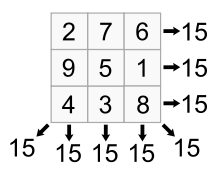
- In "wild" tic-tac-toe, players can choose to place either X or O on each move.[21][22][23]
- Number Scrabble or Pick15[24] is isomorphic to tic-tac-toe but on the surface appears completely different.[25] Two players in turn say a number between one and nine. A particular number may not be repeated. The game is won by the player who has said three numbers whose sum is 15.[24][26] If all the numbers are used and no one gets three numbers that add up to 15 then the game is a draw.[24] Plotting these numbers on a 3×3 magic square shows that the game exactly corresponds with tic-tac-toe, since three numbers will be arranged in a straight line if and only if they total 15.[27]
| eat | bee | less | →e | |
|---|---|---|---|---|
| air | bits | lip | →i | |
| soda | book | lot | →o | |
| ↙
s |
↓
a |
↓
b |
↓
l |
↘
t |
- Another isomorphic game uses a list of nine carefully chosen words, for instance "eat", "bee", "less", "air", "bits", "lip", "soda", "book", and "lot". Each player picks one word in turn and to win, a player must select three words with the same letter. The words may be plotted on a tic-tac-toe grid in such a way that a three-in-a-row line wins.[28]
- Numerical Tic Tac Toe is a variation invented by the mathematician Ronald Graham. The numbers 1 to 9 are used in this game. The first player plays with the odd numbers, the second player plays with the even numbers. All numbers can be used only once. The player who puts down 15 points in a line wins (sum of 3 numbers).
- In the 1970s, there was a two player game made by Tri-ang Toys & Games called Check Lines, in which the board consisted of eleven holes arranged in a geometrical pattern of twelve straight lines each containing three of the holes. Each player had exactly five tokens and played in turn placing one token in any of the holes. The winner was the first player whose tokens were arranged in two lines of three (which by definition were intersecting lines). If neither player had won by the tenth turn, subsequent turns consisted of moving one of one's own tokens to the remaining empty hole, with the constraint that this move could only be from an adjacent hole.[29]
- Quantum tic tac toe allows players to place a quantum superposition of numbers on the board, i.e. the players' moves are "superpositions" of plays in the original classical game. This variation was invented by Allan Goff of Novatia Labs.[30]
English names
The game has a number of English names.
- Tick-tack-toe, tic-tac-toe, tick-tat-toe, or tit-tat-toe (United States, Canada)
- Noughts and crosses or naughts and crosses (United Kingdom, Republic of Ireland, Australia, New Zealand, South Africa, Zimbabwe, India)
- Exy-ozies (verbal name only) (Northern Ireland)
- Xs and Os (Ireland, Zimbabwe, Canada, Israel)
Sometimes, the games tic-tac-toe (where players keep adding "pieces") and three men's morris (where pieces start to move after a certain number have been placed) are confused with each other.
In popular culture
- William Wordsworth alludes to tic-tac-toe in his The Prelude (1799).
- In the movie WarGames, a computer learns through a tic-tac-toe analogy that nuclear war is unwinnable.
- The BBC's Test Card F image includes a picture of a game. In the updated version, Test Card J, the game's X indicates the exact center of the screen.
- George Cooper wrote the words and John Rogers Thomas wrote the music for a song "Tit, Tac, Toe"[31] in 1876.
- The adventure game Sam & Max Save the World features an arcade version called Tic-Tac-Doom, but its artificial intelligence is intentionally poor. Rather than beating the game, the player must lose it in order to progress.
- Episode 452 of This American Life[32] recounts the true story of a legal defense team that sought to overturn the state of Florida's decision to execute a mentally ill murderer by eliciting a tic-tac-toe playing chicken as evidence. Arcade games with tic-tac-toe-playing chickens were popular in the mid 1970s; the animals were trained using operant conditioning,[33] with the moves being chosen by computer and indicated to the chicken with a light invisible to the human player.[34]
- In the 1957 film version of Twelve Angry Men there is a small scene where two jurors are playing the game in order to pass the time.
- In the Three Stooges short Disorder in the Court, Moe and Larry are seen playing tic-tac-toe in a couple of different scenes. (One with Curly playing jacks over it.)
- Elle King's debut solo single "Ex's & Oh's" references another name for Tic-Tac-Toe, with a punning allusion to her exes; and how accumulating former partners who never seem to leave her alone is a pointless, unwinnable exercise.
Various game shows have been based on tic-tac-toe and its variants:
- On Hollywood Squares, nine celebrities filled the cells of the tic-tac-toe grid; players put symbols on the board by correctly agreeing or disagreeing with a celebrity's answer to a question. Variations of the show include Storybook Squares and Hip Hop Squares. The British version was Celebrity Squares. Australia had various versions under the names of Celebrity Squares, Personality Squares & All Star Squares.
- In Tic-Tac-Dough, players put symbols up on the board by answering questions in various categories, which shuffle after both players have taken both turns.
- In Beat the Teacher, contestants answer questions to win a turn to influence a tic-tac-toe grid.
- On The Price Is Right, several national variants feature a pricing game called "Secret X", in which players must guess prices of two small prizes to win Xs (in addition to one free X) to place on a blank board. They must place the X's in position to guess the location of the titular "secret X" hidden in the center column of the board and form a tic-tac-toe line across or diagonally (no vertical lines allowed). There are no Os in this variant of the game.
- On Minute to Win It, the game Ping Tac Toe has one contestant playing the game with nine water-filled glasses and white and orange ping-pong balls, trying to get three in a row of either color. He must alternate colors after each successful landing and must be careful not to block himself.
See also
References
- Schaefer, Steve (2002). "MathRec Solutions (Tic-Tac-Toe)". Mathematical Recreations. Retrieved 18 September 2015.
- W., Weisstein, Eric. "Tic-Tac-Toe". mathworld.wolfram.com. Retrieved 12 May 2017.
- Pham, Duc-Nghia; Park, Seong-Bae (12 November 2014). PRICAI 2014: Trends in Artificial Intelligence: 13th Pacific Rim International Conference on Artificial Intelligence. Springer. p. 735. ISBN 978-3-319-13560-1.
- Golomb, Solomon W.; Hales, Alfred W. (2002). "Hypercube tic-tac-toe" (PDF). More Games of No Chance (Berkeley, CA, 2000). Math. Sci. Res. Inst. Publ. Cambridge Univ. Press. 42: 167–182. MR 1973012.
- Zaslavsky, Claudia (1982). Tic Tac Toe: And Other Three-In-A Row Games from Ancient Egypt to the Modern Computer. Crowell. ISBN 0-690-04316-3.
- Parker, Marla (1995). She Does Math!: Real-life Problems from Women on the Job. Mathematical Association of America. p. 153. ISBN 978-0-88385-702-1.
- "Tic tac toe Ancient Roman 1st century BCE". Sweetooth Design Company. Retrieved 4 December 2016.
- "Morris Games". www-cs.canisius.edu.
- . Series 2. VI. p. 152 – via Wikisource. [scan

- Oxford English Dictionary entries for "Noughts and Crosses", "Tick-Tack" and "Tick-Tack-Toe", dictionary.oed.com
- Wolf, Mark J. P. (16 August 2012). Encyclopedia of Video Games: The Culture, Technology, and Art of Gaming. Greenwood Publishing Group. pp. 3–7. ISBN 978-0-313-37936-9.
- Cohen, D.S. (12 March 2019). "OXO aka Noughts and Crosses". Lifewire. Retrieved 29 August 2019.
- "Tinkertoys and tic-tac-toe". Archived from the original on 24 August 2007. Retrieved 27 September 2007.
- Bolon, Thomas (2013). How to never lose at Tic-Tac-Toe. BookCountry. p. 7. ISBN 978-1-4630-0192-6.
- Delinski, Bernie (21 January 2014). "Searching for the cat in tic tac toe". timesdaily.com. Times Daily.
- Kevin Crowley, Robert S. Siegler (1993). "Flexible Strategy Use in Young Children's Tic-Tac-Toe". Cognitive Science. 17 (4): 531–561. doi:10.1016/0364-0213(93)90003-Q.
- Gardner, Martin (1988). Hexaflexagons and Other Mathematical Diversions. University of Chicago Press. ISBN 978-0-226-28254-1.
- Kutschera, Ant (7 April 2018). "The best opening move in a game of tic-tac-toe". The Kitchen in the Zoo. Retrieved 29 August 2019.
- Patashnik, Oren (1 September 1980). "Qubic: 4 × 4 × 4 Tic-Tac-Toe". Mathematics Magazine. 53 (4): 202–216. doi:10.2307/2689613. ISSN 0025-570X. JSTOR 2689613.
- Averbach, Bonnie; Chein, Orin (2000). Problem Solving Through Recreational Mathematics. Dover Publications. p. 252. ISBN 978-0-486-40917-7.
- Mendelson, Elliott (2016). Introducing Game Theory and its Applications. CRC Press. p. 19. ISBN 978-1-4822-8587-1.
- "Wild Tic-Tac-Toe". Puzzles in Education. 11 December 2007. Retrieved 29 August 2019.
- Epstein, Richard A. (28 December 2012). The Theory of Gambling and Statistical Logic. Academic Press. p. 450. ISBN 978-0-12-397870-7.
- Juul, Jesper (2011). Half-Real: Video Games Between Real Rules and Fictional Worlds. MIT Press. p. 51. ISBN 978-0-262-51651-8.
- Michon, John A. (1 January 1967). "The Game of JAM: An Isomorph of Tic-Tac-Toe". The American Journal of Psychology. 80 (1): 137–140. doi:10.2307/1420555. JSTOR 1420555.
- "TicTacToe Magic" (PDF). Retrieved 17 December 2016.
- "Tic-Tac-Toe as a Magic Square". Oh Boy! I Get to do Math!. 30 May 2015. Retrieved 29 August 2019.
- Schumer, Peter D. (2004). Mathematical Journeys. John Wiley & Sons. pp. 71–72. ISBN 978-0-471-22066-4.
- "Check Lines". BoardGameGeek. Retrieved 29 August 2019.
- Goff, Allan (November 2006). "Quantum tic-tac-toe: A teaching metaphor for superposition in quantum mechanics". American Journal of Physics. College Park, MD: American Association of Physics Teachers. 74 (11): 962–973. Bibcode:2006AmJPh..74..962G. doi:10.1119/1.2213635. ISSN 0002-9505.
- "Tit, tat, toe". The Library of Congress. Retrieved 29 August 2019.
- "452: Poultry Slam 2011". This American Life. 2 December 2011. Retrieved 28 May 2016.
- Trillin, Calvin (1 February 1999). "The Chicken Vanishes". The New Yorker. ISSN 0028-792X. Retrieved 29 August 2019.
- "Why did the chicken win the game? Conditioning". Star Tribune. 28 August 2018. Retrieved 15 September 2019.
External links


- "Tic-Tac-Toe". Wolfram MathWorld. 11 March 2002.
- "etymology – Why is a tie in Tic-Tac-Toe called a "Cat's Game?"". English Language & Usage Stack Exchange. 5 March 2014. - Discussion about the term "cat's game" for a drawn game of tic-tac-toe